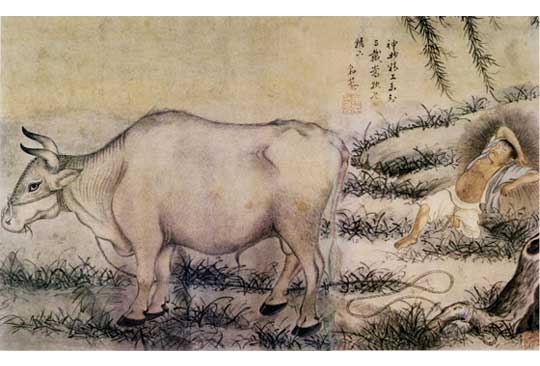Kim Tu Ryang, a representative Korean artist, and his remains
Kim Tu Ryang is one of the representatives of realistic art of 18th century developed under the influence of the ideas of Silhak school.
From his childhood, he learnt paintings systematically from his father and maternal grandfather and he was well versed in many kinds of paintings such as portrait, landscape and animal painting, especially distinguished in portrait genre painting.
“A Bull Driver”,“Landscapes of the Four Seasons”, “Landscape with the Moon”,“Dog” and the like are his masterpieces.
A Korean painting “A Bull Driver”, is one of the most famous paintings which truthfully described the daily life of a bull driver who fell asleep under a tree with his bull tied to a willow during the break time in the afternoon of the mid-summer.
The image of the bull driver in the painting shows the weary life of the farmers who were the main target of the feudal exploitation and oppression of those times. It also shows the spirit of the diligent and naive people who became stronger through hardships of their weary life.
In this painting, free from all of his anxieties, the bull driver is fast asleep on the grassland under the drooping twigs of a willow tree. The image of the bull driver who has fallen asleep wearing an untied joksam (jacket) and trousers with loosen strings make people smile and feel friendly and it is as if his belly is moving up and down slightly and the snoring sound could be heard.
Meanwhile, the image of a bull is drawn large and vivid and it seems to chew the enough cud and goggle eyes not to awake its master. It expresses the obedient and strong character of Korean draft cow, and also the bull driver’s tidy and neat grooming skill.
“Landscapes of the Four Seasons” is a scroll picture drawn by Kim Tu Ryang and colored by his son.
Top and low part of the scene is cut off so as to describe the typical environment of each season intensively and let the audience focus on the main contents of the painting.
The life of landlords of aristocracy and the life of farmers are shown in contrast with general views of farm village of four seasons. This painting was drawn by father and son together and it is the only one handed down to descendants. Father, Kim Tu Ryang drew draft well and his son also displayed great dexterity at coloring the painting to add more artistic effect and more value. As a member of the state-level painting center, Kim Tu Ryang also had some limitations such as not standing on the side of the farmers but he contributed to the enlargement of the subject area of Korean painting art and the development of the realistic painting by selecting the painting objects from the life of farmers and describing them truthfully.
